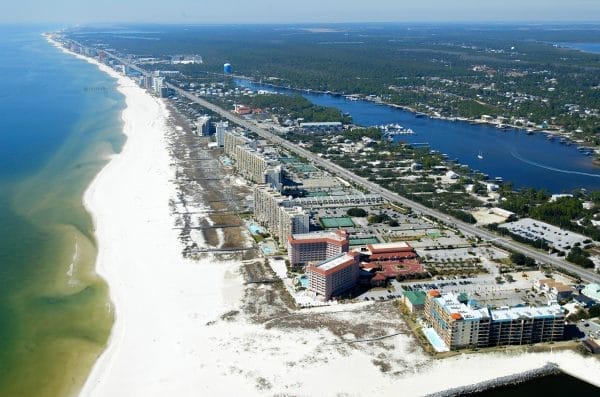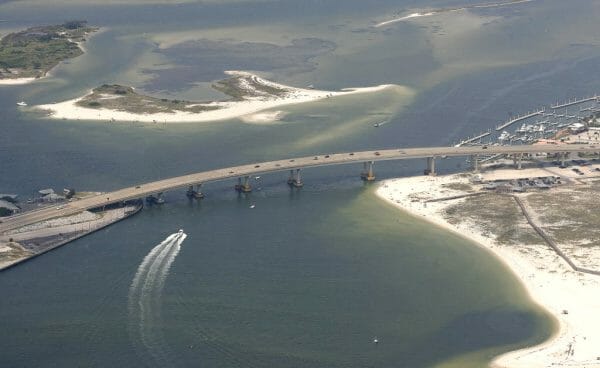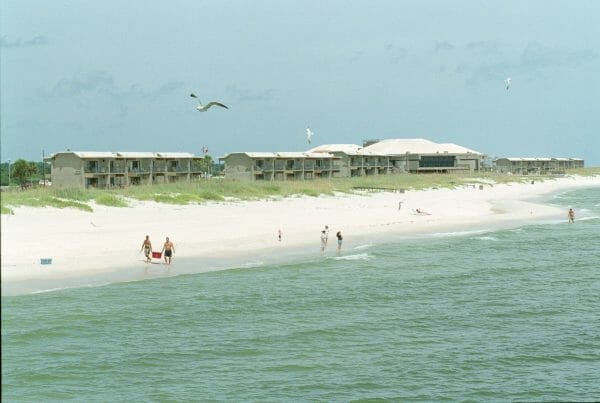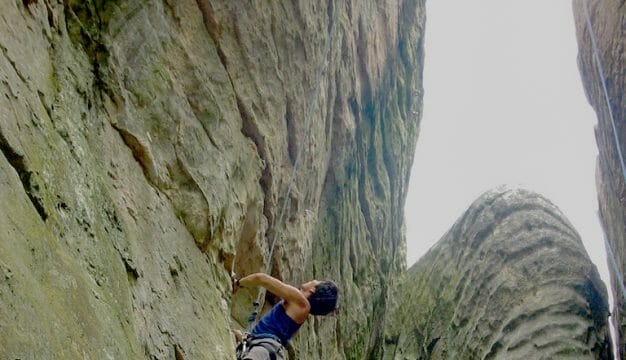Alabama's Coastline
 Orange Beach
Alabama’s coastline, home to the beaches of the Gulf of Mexico, is an important part of the quality of life for many of the state’s citizens and one of the state’s greatest economic and environmental assets. The white, sandy beaches of the coastal towns of Orange Beach and Gulf Shores and Dauphin Island are beloved and popular vacation destinations for Alabamians and out-of-state tourists. The fine quality of the sand and gentleness of the surf make for some of the prettiest beaches in the world and are the top tourist destinations in the state. The tourism industry in south Baldwin County provides more than 50,000 jobs and generates more than $2 billion in revenue annually, and beaches are the linchpin of that industry. Alabama’s shoreline along the Gulf of Mexico stretches for 60 miles. The tidal shoreline that borders all of the coastal bays, rivers, and bayous in Mobile and Baldwin counties extends another 600 miles, with the shoreline around Mobile Bay accounting for about 100 of those miles. Gulf State Park, established in 1939, encompasses 6,150 acres of beaches, dunes, marshes, freshwater ponds, and forests in the city of Gulf Shores, and Weeks Bay National Estuarine Research Reserve in Baldwin County preserves 6,525 acres of Mobile Bay’s estuarine ecosystem for scientific and environmental study and conservation.
Orange Beach
Alabama’s coastline, home to the beaches of the Gulf of Mexico, is an important part of the quality of life for many of the state’s citizens and one of the state’s greatest economic and environmental assets. The white, sandy beaches of the coastal towns of Orange Beach and Gulf Shores and Dauphin Island are beloved and popular vacation destinations for Alabamians and out-of-state tourists. The fine quality of the sand and gentleness of the surf make for some of the prettiest beaches in the world and are the top tourist destinations in the state. The tourism industry in south Baldwin County provides more than 50,000 jobs and generates more than $2 billion in revenue annually, and beaches are the linchpin of that industry. Alabama’s shoreline along the Gulf of Mexico stretches for 60 miles. The tidal shoreline that borders all of the coastal bays, rivers, and bayous in Mobile and Baldwin counties extends another 600 miles, with the shoreline around Mobile Bay accounting for about 100 of those miles. Gulf State Park, established in 1939, encompasses 6,150 acres of beaches, dunes, marshes, freshwater ponds, and forests in the city of Gulf Shores, and Weeks Bay National Estuarine Research Reserve in Baldwin County preserves 6,525 acres of Mobile Bay’s estuarine ecosystem for scientific and environmental study and conservation.
Coastal Geology
Although human activity has played an important role in the history of the Alabama shoreline, it was created primarily by hundreds of thousands of years of geologic activity. It was during the last 10,000 years, however, that sea levels rose to their present-day elevation. Sea-level fluctuations, waves, erosion, and deposition are among the many geologic processes that continue to shape the modern Alabama shoreline. Alabama’s Gulf beach sands, which are composed almost entirely of quartz grains, washed out of the ancient Appalachian Mountains hundreds of thousands of years ago. Subsequent sorting by waves and sea-level fluctuations have resulted in practically uniform sand grains, accounting for the high quality of the sand on the beaches.
 Perdido Pass
Because of their constant exposure to breaking waves, wind, and storms, coastal shoreline environments, including Alabama’s, are in a constant state of change and are usually being either eroded or built up. Breaking waves move tons of sand along the Alabama coast through a process known as “littoral drift.” The dominant direction of this sand movement is from east to west, but sand moves west to east on occasion, as well.
Perdido Pass
Because of their constant exposure to breaking waves, wind, and storms, coastal shoreline environments, including Alabama’s, are in a constant state of change and are usually being either eroded or built up. Breaking waves move tons of sand along the Alabama coast through a process known as “littoral drift.” The dominant direction of this sand movement is from east to west, but sand moves west to east on occasion, as well.
Adding to the action of waves are geographic features such as inlets or passes (narrow stretches of water between land masses), which also affect the movement of sand along the coastline. Sand naturally works its way past most inlets in a process called “sand bypassing” on shoals outside the inlet. As a result, updrift beaches lose sand, and downdrift beaches are expanded. Historically, Alabama had three inlets: Mobile Pass, Little Lagoon Pass, and Perdido Pass. But the devastation caused by Hurricane Katrina in 2005 created a new fourth inlet through Dauphin Island. Each of the passes has a significant impact on the beaches in their vicinity. Studies of beach erosion trends during the past four decades show a clear pattern of erosion on the western side of each of the three older inlets.
Human Effects
The location, and look, of almost all of the Alabama shoreline has been affected by human activity. These actions include infilling of wetlands, construction of bulkheads along the bay shorelines to serve as protective barriers to wave erosion, reconstruction of the Gulf beaches, and, primarily, engineering and dredging passes for ship channels. These humanmade waterways are a primary cause of Alabama’s beach erosion. Since 1960, more than 20 million cubic yards of sand have been removed from the beach, or littoral, system, by the dredging of Mobile Pass for the Mobile Ship Channel. Another 3 million cubic yards of sand have been dredged from the Perdido Pass Channel. The removal of these tremendous volumes of sand has resulted in severe beach erosion in the state during the past several decades because the dredging removes sand that would normally have moved down the coast and been deposited on Alabama’s beaches.
 Alabama White Sands
The solution to Alabama’s Gulf beach erosion problem is two-fold. One approach is artificial sand bypassing, a process by which dredged sand is relocated to the beaches where it naturally would have been deposited. The second is a process known as beach nourishment, which involves adding large amounts of good-quality sand to beaches to widen them. This process can be used to rebuild beaches damaged in previous decades. The first major beach nourishment project in Alabama was undertaken by the city of Gulf Shores along two and a half miles of the central business district in 2001, at a cost of approximately $6 million. It was so successful that subsequent projects were implemented to enrich another 14 miles of shoreline extending through the city of Orange Beach. These engineered beaches have been successful in two ways. First, they have saved the Gulf Shores beach that was being squeezed out between the Gulf erosion and the seawalls protecting beachfront condominiums. Second, they have reduced the damage to infrastructure, including roads and condominiums, when hurricanes have hit the coast.
Alabama White Sands
The solution to Alabama’s Gulf beach erosion problem is two-fold. One approach is artificial sand bypassing, a process by which dredged sand is relocated to the beaches where it naturally would have been deposited. The second is a process known as beach nourishment, which involves adding large amounts of good-quality sand to beaches to widen them. This process can be used to rebuild beaches damaged in previous decades. The first major beach nourishment project in Alabama was undertaken by the city of Gulf Shores along two and a half miles of the central business district in 2001, at a cost of approximately $6 million. It was so successful that subsequent projects were implemented to enrich another 14 miles of shoreline extending through the city of Orange Beach. These engineered beaches have been successful in two ways. First, they have saved the Gulf Shores beach that was being squeezed out between the Gulf erosion and the seawalls protecting beachfront condominiums. Second, they have reduced the damage to infrastructure, including roads and condominiums, when hurricanes have hit the coast.
Continued beach re-nourishment, as part of a long-term beach management plan that includes sand-bypassing at the inlets, will help sustain Alabama’s beaches in the future. In Baldwin County, for example, initial nourishments have made up for the decades of neglect, and the volumes of sand required in the future should decrease. Gulf Shores and Orange Beach have made similar strides.
Inland Shoreline
The 600 miles of tidal bay and bayou shoreline in Alabama (also primarily shaped by geology) have been affected by human activity as well. More than one-third of Mobile Bay’s shoreline has been stabilized with some type of structure. Vertical bulkheads made from rocks, wood, and other materials are the most common shoreline protection along the bay and are popularly thought to help slow wave erosion. There is little evidence, however, that such structures actually have a beneficial effect. Erosion continues bayward of the bulkhead, and eventually, the intertidal beach (the portion of sand exposed during low tide) disappears. Although this type of habitat is extremely valuable for fish, crabs, and oysters as well as for humans who enjoy the bay, it has been estimated that about six miles of intertidal Mobile Bay shoreline had been completely lost since 1900 because of bulkheads. Mobile Bay is inexorably turning into a “bathtub” with vertical walls and no intertidal areas.
 Shoreline Preservation
One possible solution to the bay shoreline problem is some form of “living shoreline” alternative to bulkheads that will protect upland property but also allow for some sandy beach or wetland. The idea of a “living shoreline” has as its basis the development of stable shorelines that function more naturally than a bulkhead. This includes sandy beaches in places where they would naturally occur (most of the bay) and emergent wetlands where they would naturally occur (upper end of the bay and many smaller bays). Two successful examples are experimental, artificial beaches on Mobile Bay stabilized with rock headland structures at Brookley’s Gulf Pines Golf Course in Mobile, built in 1998, and at the Retirement Systems of Alabama‘s Grand Hotel Resort in Point Clear, built in 2001. Current federal and state regulations allow implementation of living shorelines through a regional, programmatic permit. Alabama’s Living Shorelines General Permit (ALG10) provides for the preservation and restoration of dunes, beaches, wetlands, and submerged grassbeds, protection and propagation of essential fish habitat, and shoreline restoration and nourishment. Owing to the dynamic and variable nature of various shoreline types, to the maximum extent possible, guidelines recommend that shoreline stabilization be accomplished by the establishment of vegetation communities representative of the targeted habitat.
Shoreline Preservation
One possible solution to the bay shoreline problem is some form of “living shoreline” alternative to bulkheads that will protect upland property but also allow for some sandy beach or wetland. The idea of a “living shoreline” has as its basis the development of stable shorelines that function more naturally than a bulkhead. This includes sandy beaches in places where they would naturally occur (most of the bay) and emergent wetlands where they would naturally occur (upper end of the bay and many smaller bays). Two successful examples are experimental, artificial beaches on Mobile Bay stabilized with rock headland structures at Brookley’s Gulf Pines Golf Course in Mobile, built in 1998, and at the Retirement Systems of Alabama‘s Grand Hotel Resort in Point Clear, built in 2001. Current federal and state regulations allow implementation of living shorelines through a regional, programmatic permit. Alabama’s Living Shorelines General Permit (ALG10) provides for the preservation and restoration of dunes, beaches, wetlands, and submerged grassbeds, protection and propagation of essential fish habitat, and shoreline restoration and nourishment. Owing to the dynamic and variable nature of various shoreline types, to the maximum extent possible, guidelines recommend that shoreline stabilization be accomplished by the establishment of vegetation communities representative of the targeted habitat.
The 2010 oil spill in the Gulf had a serious impact on Alabama’s coast. Oil washed ashore several times along many of the Gulf beaches and some of the coastal bay shorelines between late June and August 2010. The economic and ecological effects of that spill continue to affect the region.
Further Reading
- Douglass, S. L. Saving America’s Beaches: The Causes of and Solutions to Beach Erosion. River Edge: World Scientific Publishing, 2002.
- Douglass, S. L., and B. H. Pickel. “The Tide Doesn’t Go Out Anymore: The Effect of Bulkheads on Urban Bay Shorelines.” Shore & Beach 67 (April/July 1999): 19-25.
- ———. “State of the Beaches of Alabama: 2000.” Mobile: University of South Alabama & Alabama Department of Economic and Community Affairs, 2000.



